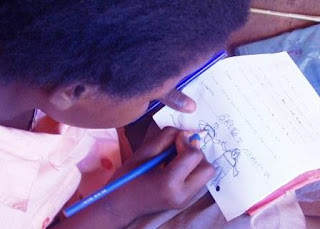 At one point I gave the 8 year old pupils some photos of Zambian children to look at and asked them what was the same or different about these children compared to themselves. After a few moments of thought, one little boy stuck his hand in the air; ‘Zambian children all sit on the floor with their legs stretched out and in England we sit with our legs crossed.’ Throughout this lesson and the next this observation kept cropping up and it struck me that being told to sit cross legged on the floor during assemblies and story time is one of my strongest primary school memories. (Much to my secondary school teachers’ dismay, I found the habit hard to break and sat with my legs crossed even after I was deemed mature enough to sit on chairs in assembly.)
At one point I gave the 8 year old pupils some photos of Zambian children to look at and asked them what was the same or different about these children compared to themselves. After a few moments of thought, one little boy stuck his hand in the air; ‘Zambian children all sit on the floor with their legs stretched out and in England we sit with our legs crossed.’ Throughout this lesson and the next this observation kept cropping up and it struck me that being told to sit cross legged on the floor during assemblies and story time is one of my strongest primary school memories. (Much to my secondary school teachers’ dismay, I found the habit hard to break and sat with my legs crossed even after I was deemed mature enough to sit on chairs in assembly.)
In contrast, Zambia is the land of straight legs. One of the veg markets in town is called the ‘ladies sitting with their legs stretched out’ market, (it does have a catchier Nyanja name that I can’t remember right now) our gardener bends from the waist to water the the plants and school children do indeed sit with their legs outstretched during story-time.
In many ways, the differences I’ve observed between children here in Zambia and those back home do boil down to things as trivial as the way they sit or the football team they support. But then, when a little Zambian kid tells me that the thing that makes him most happy is when his Daddy brings a cow home and they can drink fresh milk they suddenly seem worlds apart.

Attached to one of the organisations I work for is a community school. In Zambia, primary education is free up to Grade 7. I write free in italics because many families, despite not having to pay school fees, cannot afford to educate their children. It might be deemed rebellious in the UK to turn up to school wearing jeans instead of the standard black pleated trousers or ‘forgetting’ your tie but here a ten year old turning up to school without the same blue skirt and blouse her friends are wearing would automatically stand out as the ‘poor’ kid. A new uniform, including the right colour socks and shiny shoes would set you back 150,000 kwacha. We pay our gardener a wage equivalent to a yearly salary of 1,440,000 kwacha and he has four school-aged children to clothe, if he chose to send his children to one of the free government schools almost half his yearly income would be spent on their uniforms. On top of this, parents are also expected to equip their children with books and pens and it’s not uncommon for them to be asked to contribute when a roof springs a leak during the rains. Beyond Grade 7, a place in school costs K250,000 a year (not including uniforms).
Community schools that ask parents to contribute between 8000-15000 per term are th alternative. There are over 200 pupils at Chisomo’s community school. The class rooms are grass fences leant up against each other, creating a space little bigger than the size of a double bed or a straw mat under the open sky. The children sit with their legs stretched in front of them with their books on their laps and learn the English alphabet to the tune of Alde Lang Syne. This is where the Zambian side of my Global Ed Project takes place.


No comments:
Post a Comment